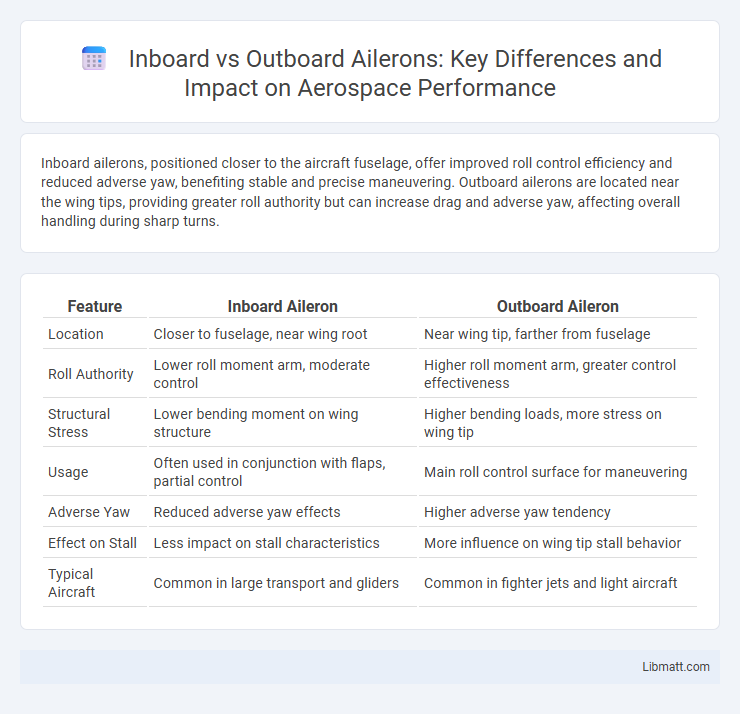Inboard ailerons, positioned closer to the aircraft fuselage, offer improved roll control efficiency and reduced adverse yaw, benefiting stable and precise maneuvering. Outboard ailerons are located near the wing tips, providing greater roll authority but can increase drag and adverse yaw, affecting overall handling during sharp turns.
Table of Comparison
| Feature | Inboard Aileron | Outboard Aileron |
|---|---|---|
| Location | Closer to fuselage, near wing root | Near wing tip, farther from fuselage |
| Roll Authority | Lower roll moment arm, moderate control | Higher roll moment arm, greater control effectiveness |
| Structural Stress | Lower bending moment on wing structure | Higher bending loads, more stress on wing tip |
| Usage | Often used in conjunction with flaps, partial control | Main roll control surface for maneuvering |
| Adverse Yaw | Reduced adverse yaw effects | Higher adverse yaw tendency |
| Effect on Stall | Less impact on stall characteristics | More influence on wing tip stall behavior |
| Typical Aircraft | Common in large transport and gliders | Common in fighter jets and light aircraft |
Introduction to Ailerons: Purpose and Placement
Inboard ailerons are located closer to the aircraft fuselage, typically on the inner section of the wing, providing enhanced roll control and stability at lower speeds. Outboard ailerons are positioned near the wingtips, maximizing roll effectiveness and responsiveness due to increased leverage from the wing's outer span. Both types serve to control the aircraft's roll axis, allowing precise maneuvering by altering the lift distribution across the wings.
Understanding Inboard Ailerons
Inboard ailerons are control surfaces located closer to the aircraft's fuselage on the trailing edge of the wing, offering improved roll control and reduced adverse yaw compared to outboard ailerons. These ailerons benefit from stronger aerodynamic forces due to their proximity to the aircraft's centerline, enhancing maneuverability and stability during flight. Understanding the aerodynamic advantages and structural integration of inboard ailerons is crucial for optimizing wing design and overall aircraft performance.
Overview of Outboard Ailerons
Outboard ailerons, positioned near the wingtips, provide enhanced roll control due to the larger moment arm from the aircraft's centerline, improving maneuverability and response. These ailerons typically create more effective control surfaces by leveraging higher airflow velocities at the wingtips compared to inboard locations. Despite increased susceptibility to adverse yaw and potential structural stresses on wing tips, outboard ailerons remain favored in many aerodynamic designs for their superior roll authority.
Key Differences Between Inboard and Outboard Ailerons
Inboard ailerons are positioned closer to the aircraft's fuselage, offering enhanced control effectiveness at lower speeds and reduced adverse yaw, while outboard ailerons are located near the wing tips, providing greater roll authority and quicker response at higher speeds. Inboard ailerons contribute to better stability and are often used on larger aircraft or those requiring precise low-speed maneuvering, whereas outboard ailerons are common on smaller or faster aircraft where rapid roll control is essential. The placement impacts aerodynamic characteristics, with inboard ailerons generating less drag and outboard ailerons experiencing higher aerodynamic loads during aggressive maneuvers.
Aerodynamic Effects of Inboard vs Outboard Ailerons
Inboard ailerons generate smoother roll control by operating closer to the aircraft's fuselage, resulting in reduced adverse yaw and improved stability at lower speeds. Outboard ailerons provide greater roll authority due to their larger moment arm from the centerline, enhancing maneuverability at higher speeds but can induce stronger adverse yaw. Your choice between inboard and outboard ailerons influences aerodynamic efficiency and control responsiveness, impacting overall flight performance.
Control Response and Aircraft Handling
Inboard ailerons, positioned closer to the fuselage, provide more precise control response with less adverse yaw, enhancing smooth and stable aircraft handling during gentle maneuvers. Outboard ailerons, located near the wingtip, deliver more immediate roll control and higher maneuverability but can increase adverse yaw and sensitivity, requiring more pilot skill to maintain balanced handling. Aircraft with inboard ailerons tend to exhibit better stability and coordinated turns, while outboard ailerons prioritize agility and responsiveness in dynamic flight conditions.
Structural Considerations and Wing Design
Inboard ailerons are positioned closer to the wing root, benefiting from stronger structural support and reducing wing twisting due to their proximity to the fuselage, enhancing control effectiveness. Outboard ailerons, located near the wingtip, maximize roll control by increasing the moment arm but require careful wing design to manage increased torsional loads and potential structural flexing. Your choice between inboard and outboard ailerons significantly impacts wing strength, weight distribution, and aerodynamic efficiency.
Advantages of Inboard Ailerons
Inboard ailerons provide enhanced control effectiveness at higher speeds due to their position closer to the aircraft's centerline, reducing adverse yaw and improving maneuverability. Their placement minimizes structural stress on the wing tips, resulting in increased durability and potentially lower maintenance costs. You benefit from smoother roll responses and better aerodynamic efficiency, especially during complex flight maneuvers.
Benefits of Outboard Ailerons
Outboard ailerons provide superior roll control by maximizing the moment arm from the aircraft's centerline, leading to more effective and responsive maneuvering. These ailerons reduce adverse yaw by generating differential lift closer to the wingtip, improving overall handling characteristics. You benefit from enhanced stability during low-speed flight and greater precision during sharp turns, making outboard ailerons ideal for both aerobatic and commercial aircraft.
Choosing the Right Aileron Placement for Your Aircraft
Selecting the correct aileron placement is crucial for optimizing aircraft control and performance; inboard ailerons provide better roll control at low speeds and reduce adverse yaw, making them ideal for slower, more stable flight conditions. Outboard ailerons enhance responsiveness and roll rate at higher speeds but may induce greater adverse yaw and require more pilot input for smooth handling. Evaluating your aircraft's operational speed, maneuverability needs, and handling characteristics will guide the appropriate choice between inboard and outboard aileron configurations.
Inboard Aileron vs Outboard Aileron Infographic

 libmatt.com
libmatt.com